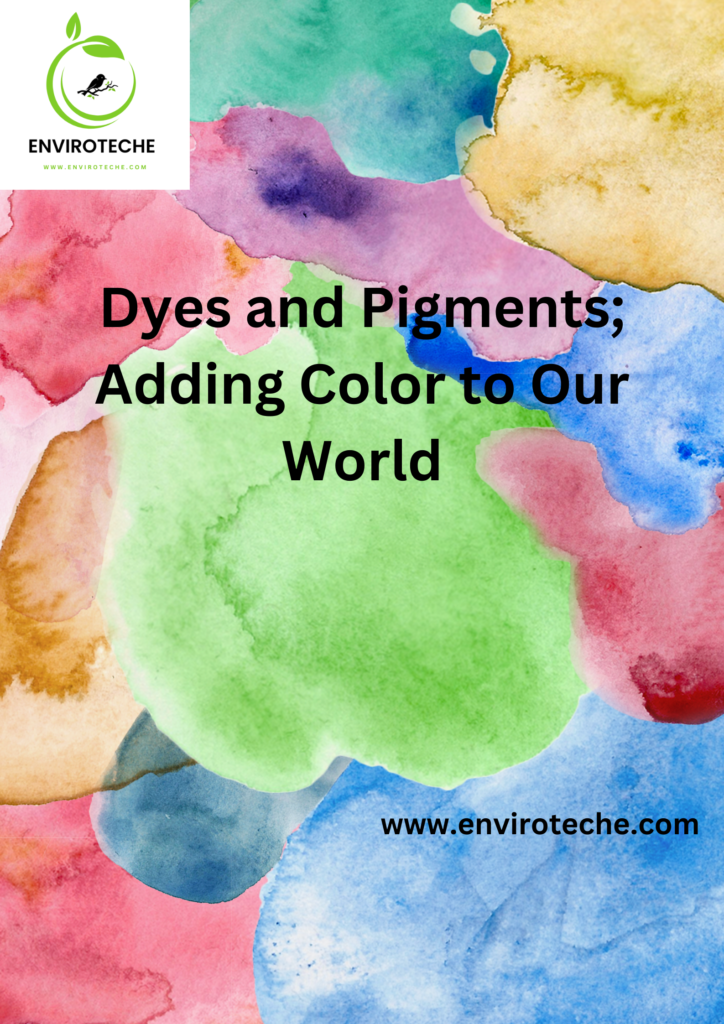Table of Contents

What are dyes?
The dye is a pigmented substance that interacts chemically with the surface it is applied on. Unlike pigments, which do not chemically bind to the material they colour. While applying the dye, which is commonly done in an aqueous solution, a mordant may be required to improve the dye’s fastness on the fibre. Dyeing is the process of coloring many materials, including paper, textiles, leather goods, as well as some biological specimens (Chequer et al., 2013). Their main purpose is to impart color to the material they are applied on. Natural or synthetic dyes can be used, and several methods are used to achieve the desired coloring effect.
Types of dyes:
There are two types of dyes which are given below:
- Natural dyes: These colors come from minerals, plants, or animals. Before the invention of synthetic dyes, natural colors were the main source of colorants (Affat, 2021). Indigo (from the indigo plant), cochineal (from insects), or madder (from the madder root) are some examples.
- Synthetic dyes: The most popular sort of dye nowadays is synthetic, which is produced chemically. According to their chemical structure, they can be divided into different categories, including dyes made from azo compounds, anthraquinone dyes, and phthalocyanine dyes (Gurr, 2012).
Solubility and Chemical Structure of dyes:
Most dyes can be dissolved in a liquid media, like water or a substance called a solvent. They can bind and penetrate the material that they are coloring and thanks to their solubility.
Chromophores, which play a key role in absorbing or reflecting light as well as the subsequent sense of color, are present in the chemical makeup of dyes (Fabian & Hartmann, 2013). The color of a dye molecule is determined by its particular chemical structure.
Dyes vs Pigments:
Pigments and colors are the two main categories ocolorantsts. The main difference between the two is that while dyes are soluble and suspended in a medium or binder, pigments are insoluble and are not. This is because the varied particle sizes of colors and pigments lead them to react in distinct ways. These are the most significant colors used to add color or alter color are colors and pigments. The textiles pharmaceutical, food, cosmetic, plastic, paint, ink, photography, and paper industries all utilize them extensively.
colors are colored compounds that are liquid or dissolve throughout the application procedure and add color by absorbing light only in certain places. Colored, colorless, or florescent pigments are small, finely split organic or inorganic solids that are often insoluble in and essentially unaffected chemically by the vehicle or media in which they are used. On the opposite hand, the relationship between light and material is what causes color, which is greatly influenced by the physical and chemical features of matter.
Chemical interaction of dyes and pigments:
- Dyes: Chemical bonds that colors can establish with the substance include covalent connections, ionic interactions, hydrogen bonds, and van der Waals forces. The dye’s color is produced by this bonding.
- Pigments: Instead of forming a chemical link with the substance, pigments sit on its outermost layer or dissolve in the medium. The pigment particles’ ability to reflect and absorb light is what gives the color.
Opacity of dyes and pigments:
Most colors are translucent and leave the underlying surface unobstructed while Pigments can cover and conceal the underlying surface since they can be opaque. They are thus appropriate for situations that call for complete covering.
Environmental concerns:
- Wastewater pollution: The printing and dyeing of textiles produce a sizable volume of wastewater. If not adequately managed, these leftover chemicals, heavy metals, and colors can contaminate water sources, hurting aquatic creatures and ecosystems (Khan et al., 2022)
- Energy and water usage: Textile dyeing and finishing procedures can be water and energy-intensive. Increased consumption of energy and water shortage are two environmental effects of high resource utilization.
- Disposal: Waste dye and pigment disposal can be difficult. Inadequate disposal can contaminate the soil and endanger the surrounding flora and animals (Shabir et al., 2022).
- Toxic chemicals: Some pigments and colors, especially some synthetic colors, may include hazardous substances that are bad for the environment. For instance, some of the heavy metals used in dyes may hurt the environment.
Health concerns:
- Skin sensitization and allergies: Due to close interaction with colors and chemicals, people who deal with dyes, especially in sectors like the textile industry, may be at risk for skin sensitization and allergies.
- Respiratory issues: Respiratory issues can result from inhaling pigments dust or aerosols in fields where pigments are employed, such as paint manufacture.
- Toxic chemical exposure: Certain dyes and pigments, particularly more ancient or less regulated types, may contain harmful ingredients. Continuous exposure to these substances may have negative health effects, including the development of cancer.
- Occupational risks: If workers in sectors that use pigments and dyes don’t follow the recommended safety precautions, such as employing ventilation systems and wearing protective clothes, they could put themselves in danger.
In the dyeing and pigmentation industries, there is a rising focus on sustainable and eco-friendly procedures to solve these issues. This entails the creation of eco-friendly dyes or pigments, enhanced waste disposal techniques, and the adoption of more secure and sustainable production techniques. To safeguard both human well-being and the environment, regulatory organizations are also involved in establishing security requirements for colors and pigments. Additionally, consumers have the option to purchase goods created using eco-friendly colors and pigments.
Applications of dyes and pigments:
The applications of dyes and pigments are given below:
- Textiles: To color textiles, clothing, and other fibers, dyes are frequently employed. They are essential to the clothing and textile sectors because they offer a wide range of colors.
- Inkjet and laser printing: To produce colored texts and images on paper and other printing materials, colors are employed in jet and laser printing.
- Leather: For color, colors are put into leather, which is used in items like furniture, shoes, and purses.
- Food coloring: Food and drinks are colored using food dyes to improve their aesthetic appeal. This covers colored soft drinks, processed meals, and candy.
- Cosmetics: Makeup including colored lipstick, eyeshadow, and nail polish contains colors, enabling a wide range of color options.
- Medical stains: In laboratories, colors are used to color cells and tissues, facilitating microscopic examination.
- Biotechnology: For the separation as well as analysis of protein, RNA, and DNA via gel electrophoresis, colors are used in biotechnology.
- Paints and coatings: For use in industrial, automotive, and architectural paints and coatings, pigments are a key ingredient. They offer both color and safety.
- Plastics: Plastics can be used for a variety of plastic items because pigments are added to them to give them color and UV resistance.
Both pigments and colors are essential for giving color to a variety of goods and materials, having an impact on a variety of industries including fashion, printing, production, and more. Their selection is influenced by the application’s requirements as well as elements like transparency and opacity.
Conclusion:
Finally, it should be noted that pigments and dyes are essential instruments for giving color to a wide range of materials and goods across numerous industries. These vibrant substances not only improve our world’s aesthetic appeal but also perform crucial tasks in a variety of applications. Dyes are excellent in coloring clothes, inks, and beauty products due to their solubility and capacity to create chemical bonds.
The ideal option for paints, materials of plastics, ceramics, and a wide range of applications wherever opacity and durability are crucial is pigment, which stays insoluble and uses physical dispersion for color. However, because using some color and pigments might pose a danger to our health and the environment, it’s crucial to be mindful of these issues.
References:
Affat, S. S. (2021). Classifications, advantages, disadvantages, toxicity effects of natural and synthetic dyes: A review. University of Thi-Qar Journal of Science, 8(1), 130-135.
Chequer, F. D., De Oliveira, G. R., Ferraz, E. A., Cardoso, J. C., Zanoni, M. B., & De Oliveira, D. P. (2013). Textile dyes: dyeing process and environmental impact. Eco-friendly textile dyeing and finishing, 6(6), 151-176.
Fabian, J., & Hartmann, H. (2013). Light absorption of organic colorants: theoretical treatment and empirical rules (Vol. 12). Springer Science & Business Media.
Gurr, E. (2012). Synthetic dyes are used in biology, medicine and chemistry. Elsevier.
Khan, W. U., Ahmed, S., Dhoble, Y., & Madhav, S. (2022). A critical review of hazardous waste generation from textile industries and associated ecological impacts. Journal of the Indian Chemical Society, 100829.
Shabir, M., Yasin, M., Hussain, M., Shafiq, I., Akhter, P., Nizami, A.-S., Jeon, B.-H., & Park, Y.-K. (2022). A review on recent advances in the treatment of -polluted wastewater. Journal of Industrial and Engineering Chemistry, 112, 1-19.
Authors detail:
Tayyba Shakir, Aisha Ghaffar
Department of Chemistry, University Of Agriculture Faisalabad, Sub-Campus Toba Tek Singh
Check Other Scholarships:


